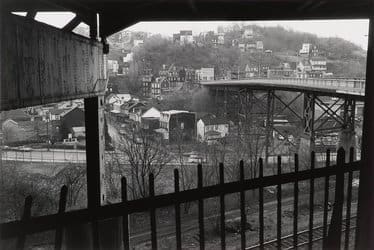Lee Friedlander’s Factory Valleys
Judith Bear Isroff & Fred and Laura Ruth Bidwell Galleries
Check out 89.7 WKSU's
coverage of the exhibition!Lee Friedlander’s Factory Valleys series, conceived 30 years ago, has come to be recognized as a milestone both in the artist's career and in the history of documentary photography. The Akron Art Museum, which commissioned the work, revisits the project by exhibiting around 50 vintage photographs, all from the museum’s collection. This exhibition coincides with a major Friedlander retrospective at the Cleveland Museum of Art, also on view through May 31, 2009.
In 1979 Akron’s director, John Coplans, invited Friedlander to photograph America’s industrial belt. Although once a prime source of the nation’s wealth, the industrial Heartland was spiraling into an economic recession in the late 1970s. The artist decided to focus on Ohio and Pennsylvania. Steel mills and tire plants were closing, but it was not yet evident that this was a massive permanent decline in American manufacturing. Not until 1982, the year that Factory Valleys was exhibited, did the terms “Rust Bowl” and “Rust Belt” first appear.
Friedlander photographed the components of an industrialized region: the countryside, towns, steel plants and factories, workers’ houses and the roads and railroads that transported both raw materials and manufactured goods. He captured workers’ symbiotic relationship to their machines, ennobling their labor while stressing its machinelike repetitiveness. Although he photographed in all four seasons, the land does not appear hospitable, lush or fertile. It seems fragile and ravaged, reflecting a new sensitivity to the environment that was awakening in the late 1970s.
Friedlander also used the Akron Art Museum commission as an opportunity to advance radical compositional solutions. The visual chaos of his images of the factory towns echoes the emotional and social disruption he found there. Factory Valleys melds formal experimentation, documentation and personal expression to produce a statement that sums up its time and its creator’s experiences.
This exhibition was organized by the Akron Art Museum and made possible by a generous gift from Mark Schwartz and Bettina Katz.

